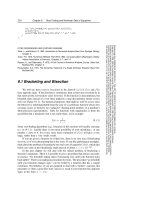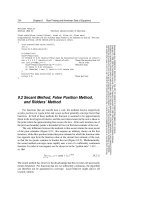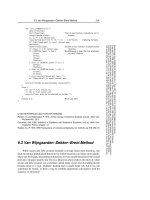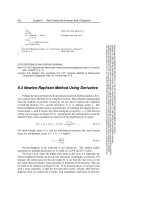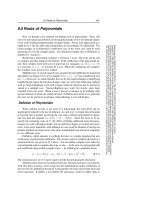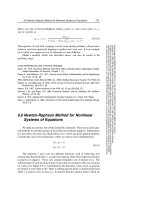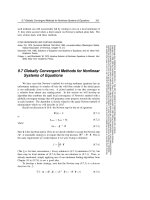Tài liệu Physical health and functional ability of an elderly, population in Sri, Lanka doc
Bạn đang xem bản rút gọn của tài liệu. Xem và tải ngay bản đầy đủ của tài liệu tại đây (426.91 KB, 8 trang )
Physical health and functional ability of
an
elderly, population in
Sri,
Lanka
D.
N. Fernando
1
and R. de
A.
Seneviratna
2
The
Ceylon
Journal
of
Medical
Science
1993;
36:9-16
Summary
Demographic changes occurring
in
the past few
decades have resulted
in an
increase
in
both
the
proportion
and in the
absolute numbers
of
elderly persons
in
many developing countries,
where services
for the
elderly
are
limited.
Assessment
of
physical health
and
functional
ability
of
this group forms
a
basis
for
formulation
of
policies
and
programmes
for
provision of such services.
A community based study aimed
at
obtaining
the above information
was
carried
out in a
province
in
Sri Lanka, using several approaches
- self-assessment
of
health status; self-reported
health problems, functional status measures and
physical performance measures.
The
findings
indicated
the
common health problems
to be
associated with vision, hearing, mastication and
mobility. Other conditions requiring long-term
care such as arthritis and hypertension were also
important. Self-assessment
of
health,
a
good
predictor
of
morbidity
and
mortality
was
associated with several psychosocial variables.
Data indicated that number
of
years
of
life
expectancy, free
of
problems associated with
activities of daily living, was relatively low.
Programmes aimed
at
limiting disability among
this group have
to be
considered along with
those for provision of care.
Introduction
Aging
of the
population
is a
phenomenon
present
in
both developing
and
developed
countries. Sri Lanka, a country which has shown
an,increasing life expectancy
at
birth
and
reducing mortality rates in the past few decades,
is likely
to
experience
an
increase
in the
proportion
of
the elderly population,
in
the next
few years.
It
is estimated that the population 60
years
and
over will constitute 8.5%
in the
year
2000 and
15.2%
by the year
2025
(1).
Most
of the
developed countries have health
and social welfare programmes
for
this
age
group. Hence
a
majority
of
reported studies
on
health status are from such countries (2, 3). The
main concern
of
these countries at present seems
to
be, not the
provision-of services
for the
requirements
of the
elderly,
but
planning
approaches
to
increase healthy life expectancy
(4).
In developing countries,
the
major concern
during the latter part
of
this century has been
to
develop services aimed
at
reducing mortality
and morbidity. The demographic changes which
have resulted from these activities will lead
to
an increase
in the
proportion
as
well
as in the
absolute numbers
of the
elderly population.
.
These changes make
it
necessary that
appropriate health and other support services be
developed.
Measures
of
physical health
and
functional
ability
of
elderly populations based
on
community studies are likely
to
provide useful
background data
for
planning such
programmes.
Methodology
A descriptive community based study aimed
at
studying
the
physical health status
and
functional abilities in the elderly was carried out
in
the
three districts comprising
the
Western
province
of
Sri Lanka.
Of
the total population of
the country 26% reside
in the
area included
in
the study. A three stage sampling procedure was
used to identify the sample of elderly, defined
as
those aged
60
years and over.
1
Professor
2
Senior
Lecturer,
Department
of
Community
Medicine,
Faculty
of
Medicine,
University
of
Colombo, Colombo.
10
D.
N.
Fernando
and R. de A.
Seneviratna
In each district, 10 urban and 10 rural areas were
identified based on census data and using the
probability proportional to size technique. From
each of the selected areas, one cluster was
randomly selected from the electoral wards in
the urban areas and from the Grama Niladhari
divisions (smallest administrative units) in the
rural areas. Using the electoral register for each
of the clusters, 20 persons of age 60 years and
over were identified. Attempts were made to
include an approximately equal number of
persons in the age groups 60 - 64 yr, 65 - 69 yr
and 70 yr and over. This process enabled
inclusion of a sample of 1200 elderly persons.
The main approach for data collection was
through an interviewer administered
questionnaire. Field level health workers were
trained to carry out these interviews. Re-tests
were done on a 5% sample to ensure quality of
data.
Assessment of health status at community level
requires the use of methodologies that are
feasible in such settings and also shown to be
valid as predictors of mortality and morbidity.
Thus,
self-reported functional status measures
and physical performance measures were used
to assess the health status of the elderly
population included in the study. Among the
self-reported measures were: self-assessment of
health based on the reponse to the question "Are
you feeling healthy ?", reporting of an accident,
injury or illness within the year preceding the
survey, information on problems related to
mastication and to mobility.
Simple clinical examinations were carried out to
identify problems with vision and hearing.
Visual problems were detected using a modified
Snellen's Chart E version, a score of 18 and over
being considered as having 'poor' vision.
Hearing disorders were assessed by the
following procedure: the interviewer stood 3
metres behind the subject in a quiet room. After
3 test words were repeated to familiarise the
subject with the procedure, each ear was tested
by saying 3 words at a constant volume. The
subject was then asked to repeat the words, and,
even if one word was repeated incorrectly, it was
recorded as 'impaired hearing'.
Assessment of functional ability was made on
the responses to 11 questions on the ability to
perform "activities of daily living (ADL)" (5).
Seven of these activities are related to personal
activities, hence termed as "personal activities of
daily living (PADL)" - ability to eat, dress, take
care of appearance, walk, go to toilet, get in/out
of bed, take a bath. Other 4 activities are referred
to as "instrumental ADL (IADL)" and included
ability to travel outside, go shopping, prepare
own meals and handle money.
A limited number of tests of physical
performance for assessing the functioning of
upper and lower extremities were carried out,
using standard procedures. These included:
semi tandem stand, full tandem stand, rising
from chair without using arms and shoulder
external rotation (full).
A younger member of the household present at
the time of the interview was identified as an
"informant". At each interview where an
informant was present, assessment of the
informant of the health status of the elderly
person was obtained.
Results
The non-response rate for the study was only
1.7%. In response to the question "Are you
healthy ?", 49% of males and
38%
of the females
said that they felt healthy. A consistent decrease
in the proportion of healthy was seen with age
for both sexes (Table 1).
Prevalence of visual, hearing, dental problems
and problems related to mobility increased with
age and was commoner among females within
each age group (Table 2). Visual problems were
the commonest and was found in 65% of the
total group and the problems of hearing and
mastication were present in 21% and 30%
respectively.
Health problems reported ranged widely, the
commonest being "arthritis", which was
reported by 32% of the total group. High blood
pressure (22%), heart (14%) and lung diseases
(14%) were the next common reported health
problems.
Tlie
Ceylon
Journal
of
Medical
Science
Physical
health
and
functional
ability
of
an
elderly
population
in Sri
Lanka
11
Sex 60-
65-
70-
75
-
80
+
Total
Males
127
81 46
25 17
296
(43)
(28) (15)
(8) (6)
(49)
Females
89
54
41 17 17
218
(41)
(25) (18)
(8) (8)
(38)
Table 2.
Percentage of persons.who
had
identified
problems
by
age and
gender
1.
Males
Age
in years
i'
Problem
60-
65-
70-
75-
80-
Total
i'
Problem
n
=
217
n
= 158
n
= 115
n
=
70
n
= 52
n
=
612
•
% %
% % % %
Visual problems
57
60
79
67
74 64
Hearing problems 10 18 25 22 45 19
Dental prosthesis 12 18 8
7
9 9
Difficulty
in
chewing 21 26 31 32 53 28
Problems with feet 4 7 9 4 8 6
Difficult to walk 300 metres 7 8 14
28 35
23
Z
Females
Age
in years
Problem
60-
65-
70-
75-
80-
Total
Problem
n
= 217
n
=
152
n
= 107
n
=
70
n
=
52
n
= 588
%
% % %
%
%
Visual problems
61 69
63 73
84 67
Hearing problems 16 22 25
32 51 24
Dental prosthesis 13 17 16 16 4 14
Difficulty
in
chewing 26 30 30 49 42 32
Problems with feet 5 4 11 6 7 6
Difficult
to
walk 300 metres
11
21 27 35 49
23
82%
of the
males
and
76%
of the
females were
able
to
carry
out all
seven PADL activities
without help. However, performance
in
IADL
activities
was
much lower
in all age
groups
(Table
3).
The
number
of
persons able
to
carry
out individual activities varied, with some
differences between
the
genders
(Fig. 1). In
general, males performed better than females
in
all activities except
in
"preparation
of own
meals". This
may be due to the
tradition
in Sri
Lankan society, where preparation
of
meals
is
considered
a
woman's responsibility.
Vol.
36 No.
1,
June
1993
I
Table
1.
Number and
percentage
of
persons
"feeling
healthy"
within
each
age/gender
group
12
D.
N.
Fernando
and
R.
de
A.
Seneviratna
Table 3. Number and % (in parenthesis) within each age/gender group who could carry out
"activities of daily living"
Activity
60-
65-
Age in years
70-
75-
80 +
Total
All PADL
males 193
174 92
48 18 525
(89) (88) (79)
(71) (45) (82)
females 148 154 71 37 19 429
(87)
(79) (74)
(67) (40) (76)
All IADL
males 101
69 34
11 5 220
(49) (35)
(29)
(16) (15) (34)
females 95 67 26 12 3 203
(56) (35) (28)
(22)
(6)
(36)
activity
transport
shopping
prepare meals
handle money
can eat
can undress
appearance
can walk
in/out bed
bath/shower
toilet
20
40 60 80
% able to perform
Hi males HH females
100
120
Fig. 1. Ability to perform ADL.
Analysis by gender
Tlie
Ceylon
Journal
of
Medical
Science
Physical
health
and
functional
ability
of
an
elderly
population
in
Sri
Lanka
13
Table 4. Number and % (in parenthesis) in each age/gender group able to carry out physical
performance tests
Test
60-
65-
Age in years
70-
75-
80
+
Total
Semi tandem stand
313
289 122
68 28
822
(82)
(73)
(57) (55)
(32)
(68)
Full tandem stand
297
260
113 58
24
740
(77)
(66)
(53) (47)
(28) (63)
Able to rise without
using arms
320
311
147 72 33
870
(84) (71)
(69) (59) (38) (74)
Shoulder external
rotation 266 252
122
57 31
728
(69)
(64) .
(57) (46)
(36)
(61)
Performance based measures were carried out
by 1038 (83.5%) of the total group, others not
being able to do so, due to injury or an illness.
Best performance was in "standing from chair
without using arms" (84%), semi tandem stand
was completed by
78%
and full tandem stand by
72%.
The poorest performance was in shoulder
external rotation (69%). The proportion able to
carry out these tests decreased with increasing
age (table 4).
Some psychosocial factors and indicators of
health service use was studied in relation to
"self^assessed" health status (Table 5). It was
seen that more of those who felt healthy had
adequate contacts with their relatives and
participated in family decisions. They were also
satisfied with their environment and financial
status and more of them worked outside home.
Use of health care services was significantly
lower among those who reported themselves to
be healthy. Better health status was significantly
associated with increased ability to complete the
physical performance tests and in carrying out
ADL (Table 6).
Informants were present in 1167 (97%) of the
interviews. Comparison of the physical health
rating made by the informant with
'self-
iassessment' indicate that the elders rate their
level of health to be marginally lower when
compared with that of the informant (Table 7).
Only 66% of the elders whose health was
assessed as "good" by the informant said that
they felt healthy, compared with the 93% who
agreed with the informants when their health
status was assessed as "poor".
Using the data from the present study, measures
of active life expectancy were developed using
the available methods (6). Even though years of
total life expectancy at 65 years was 13.2 years
for males and 14.72 years for females, years of
life expectancy free of problems with ADL
activities was relatively low for both genders
(Table 8).
Discussion
Identification of health problems and functional
ability of an elderly population is of importance
to health planners and policy makers, as such
data are likely to provide guidelines in deciding
the appropriate options for a service for care of
the elderly.
Several longitudinal studies have shown that
self-assessment of health status is a good
predictor of morbidity and mortality (7, 8, 9).
Using this index, the proportion "feeling
healthy" was
43%
which is low when compared
with similar observations made in other
countries in the region: 56% in Myanmar, 84% in
Indonesia and 62% in Thailand (10). It was
Vol.
36No.l,June
1993
14
D.
N.
Fernando
and
R.
de
A.
Seneviratna
Table 5. Self-assessed "health status" by some psychosocial factors and indicators of use of
health services
Self-assessment of health
Variable
healthy (n
=
%
=
513)
not healthy (n = 647)
%
Psychosocial factors
Visits relations enough
49
38 **
Visited by relatives often
52
42 *
Works outside the house
21
12 *
Has enough money
58
47 *
Participates in family decisions 61 42 **
Satisfied with environment 47 37 *
Health care use (during past month)
No visits to doctor
73
45 "
Not taken traditional medications
86
75 **
Not taken prescribed medications
79
52 **
Not taken over the counter medications
81 75 **
The level of statistical significance between the two groups using x
2
statistic are given as follows:
* p<
0.005
** p<
0.0001
Table 6. Persons able to perform physical tests and activities of daily living, by self-assessed
health status
Feeling healthy
Yes No
(n - 518) (n
=
664)
% %
p value
(using x
2
)
Physical performance test
Semi tandem stand
85
55
Full tandem stand
81
46
Able to sit up without using arms
87
63
for all
Shoulder external rotation
78
47 comparisons
Ability to do activities of daily living
(ADL) p< 0.00001
all PADL
52 29
all IADL
94
70
all ADL
47
30
Tlie
Ceylon
Journal
cf
Medical
Science
Physical
Itcalth
and
functional
ability
of
an
elderly
population
in Sri
Lanka
15
Informant
assessment
Self-assessment
healthy
not
healthy
n n
%
agreement
Good
n
=
652
431 221 66
Fair n
=
351
71
280 20 ~
Poor
n
=
164
12
152
93
** %
agreement
for
this group has been calculated taking the informant assessment of health "fair"
as indicating satisfactory health status.
Table
8.
Life
expectancy
measures
at
age
65
Males
Females
Total life expectancy in years
(LE)
13.2 14.72
Years
of
life expectancy free
of
problems with
PADL
12.32
13.43
Years
of
LE
free of problems with all
ADL
7.81
8.33
%
of
total
LE
free
of
problems with
PADL
93.3
91.2
%
of
total LE free
of
problems with all
ADL
59.2
56.6
shown that those
who
assessed their health
status as "poor"
had
reduced functional abilities
and used health services
to a
greater extent.
These observations when taken together with
the relatively high proportion
of
elderly persons
who reported themselves
"not
healthy" should
be taken into account
in
planning appropriate
programmes.
This study indicates that most
of the
common
problems in' this
age
group require long-term
care
and
supportive services,
(e.g.
arthritis,
problems with vision) some
of
which need
collaboration with sectors outside
the
health
sector.
In most developed countries where
the
health
services
for the
elderly
are
well organised,
the
emphasis
at
present
is to
reduce disability
and
prolong "healthy life expectancy" (11).
In
countries like United States
of
America, concern
has been expressed
at
national level that unless
dependence among elderly is reduced, there will
be more people needing care than those who
are
able to provide care (12).
The observation that
the
number
of
years
of
healthy life expectancy
is low
compared with
total life expectancy indicates
the
need
for
paying attention
to
programmes aimed
at
preventing
and
postponing disability
and
dependency. Such emphasis
is
essential
for
improving
the
quality
of
life
of
the elderly, even
in developing countries. Thus,
in
addition
to
provision
of
curative services, other services
such
as
development
of
appropriate screening
programs, improvement
of
supportive care
at
institutional
and
field level, will have
to be
considered
in
planning programs
for
the elderly.
Monitoring
of
health problems
in the
elderly
have
to be a
component
of
health services
for
Vol.
36 No. 1,
June
1993
Table
7.
Comparison of informant
assessment
of
health
status
with
self-assessment
16
D.
N.
Fernando
and
R.
de
A.
Seneviratna
this group, as changing patterns of health
problems could arise, as cohorts of differing
'exposures' enter the age group considered as
elderly.
Acknowledgements
This article is based on the intercountry study
sponsored by the World Health Organisation,
South East Asian Regional Office
(WHO/SEARO), New Delhi on "Health and
Social Aspects of the Elderly". We are grateful
for the financial assistance provided by the
WHO/SEARO and the technical assistance by
Professor Gary Andrews, Centre for Aging
Studies, Flinders University of South Australia,
Adelaide, Australia.
We wish to thank Dr. Joe Fernando Secretary,
Dr. George Fernando Director General of Health
Services of the Ministry of Health and Women's
Affairs, Sri Lanka and Dr. U. H. S. de Silva
Director (Health) Western Province for the co-
operation extended. We are grateful to all
Family Health Workers and all participants.
References
1.
Ministry of Health and Women's Affairs, Sri
Lanka, Population Information Division,
Population Information Centre.
Population
Statistics
of Sri
Lanka
1992.
2.
Jette A M, Branch L G. The Framingham
Disability study II. Physical disabilty among
the aging
American
Journal
of
Public
Health
1981;
71(11):
1211-1216.
3.
Bowling A, Farquhar M, Browne P. Use of
services in old age: data from three surveys
of elderly people.
Social
Science
and
Medicine
1991;
33(6):
689-700.
4.
Fries J F. Aging, natural death and the
compression of morbidity.
Tlie
New
England
Journal
of
Medicine
1980;
303:130-135.
5.
Katz S, Apkom C A. Index of activities of
daily living
Medical
Care
1976; 14(5 Suppl):
116-118.
6. Katz S, Branch L G, Branson M H, Papsidero
J A, Beck J C, Greer D S. Active life
expectancy. The New
England
Journal
of
Medicine
1983;
300(20):
1218-1224.
7.
Wannamethee G, Thapa A G.
Self-
assessment of health status and morbidity in
middle aged British men.
International
Journal
of
Epidemiology
1992;
20(1):
239-245.
8. Fyljenses K, Forde O H. The Tromso Study:
Predictors of self-evaluated health - has
society adopted the expanded health
concept ?
Social
Science
and
Medicine
1991;
32(2):
141-146.
9. Maddox G L, Douglas E B. Self-assessment
of health - a longitudinal study of elderly
subjects.
Journal
of
Health
and
Social
Belmviour
1974;
14:84-93.
10.
Centre for Aging Studies, Flinders
University of South Australia Adelaide,
Australia.
Aging
in
South
East
Asia
-
a
five
country
study
Intermediate
Report.
1991.
11.
Ichiro Kai, Ohi G, Kobayashi Y, Ishizaki T,
Hisata M, Kinchi M. Quality of life: A
possible health index for the elderly.
Asia
Pacific
Journal
of
Public
Health
1991;
5(3):
221-
227.
12.
Kovar M J, Feinleito M. Older Americans
present a double challenge: preventing
disability and providing care.
American
Journal
of
Public
Health
1991;
81(3):
287-288.
The
Ceylon
Journal
of
Medical
Science

